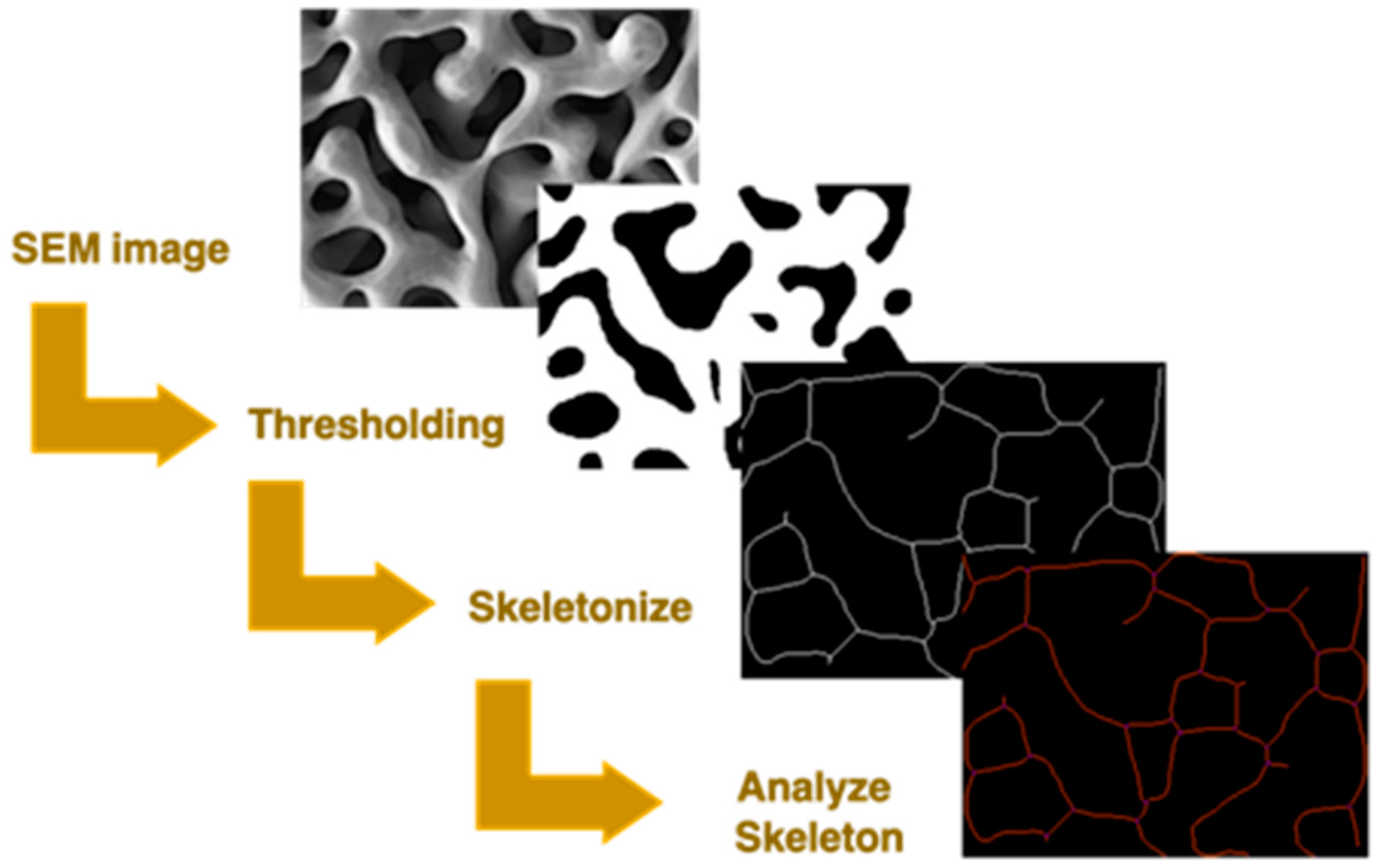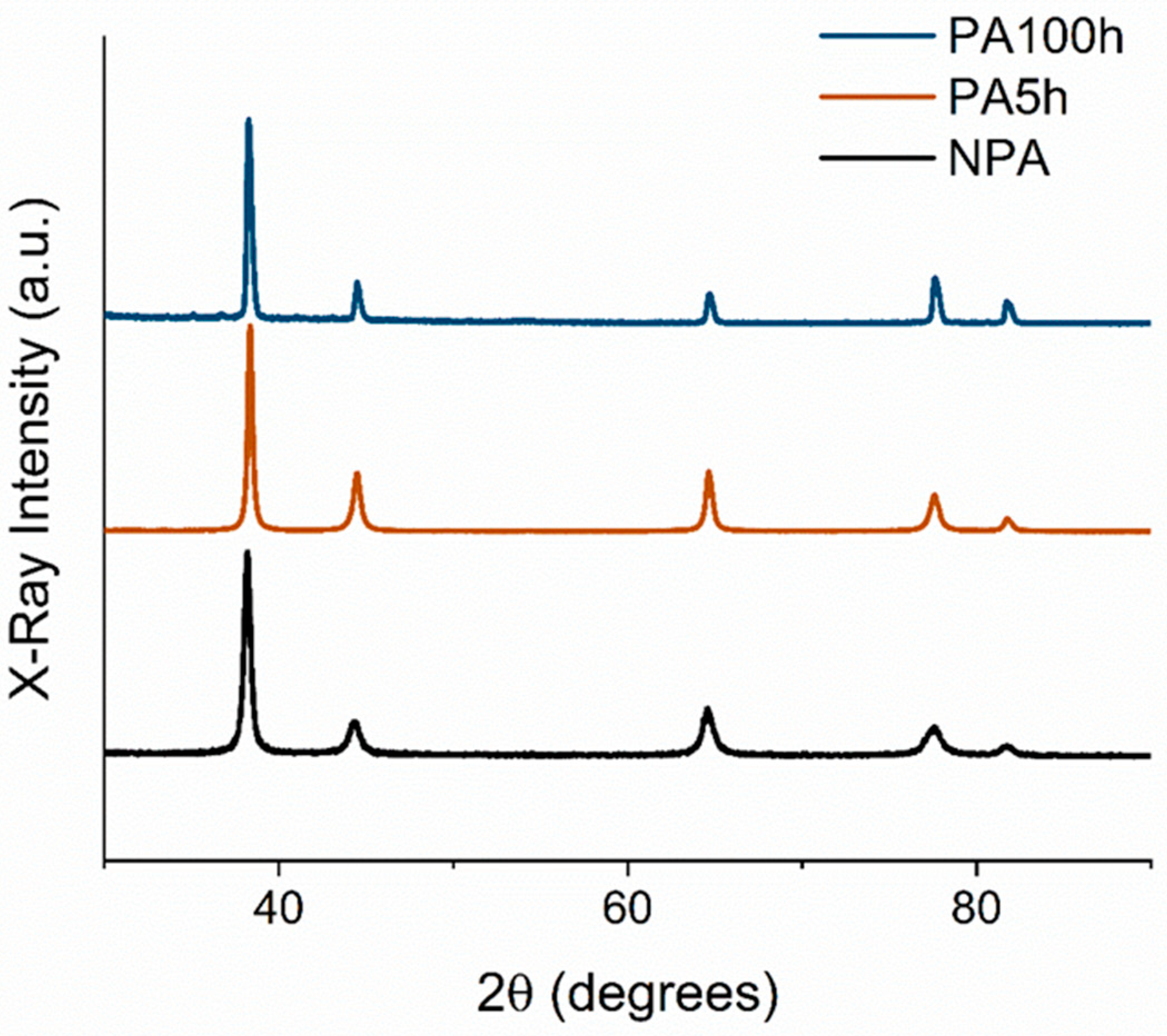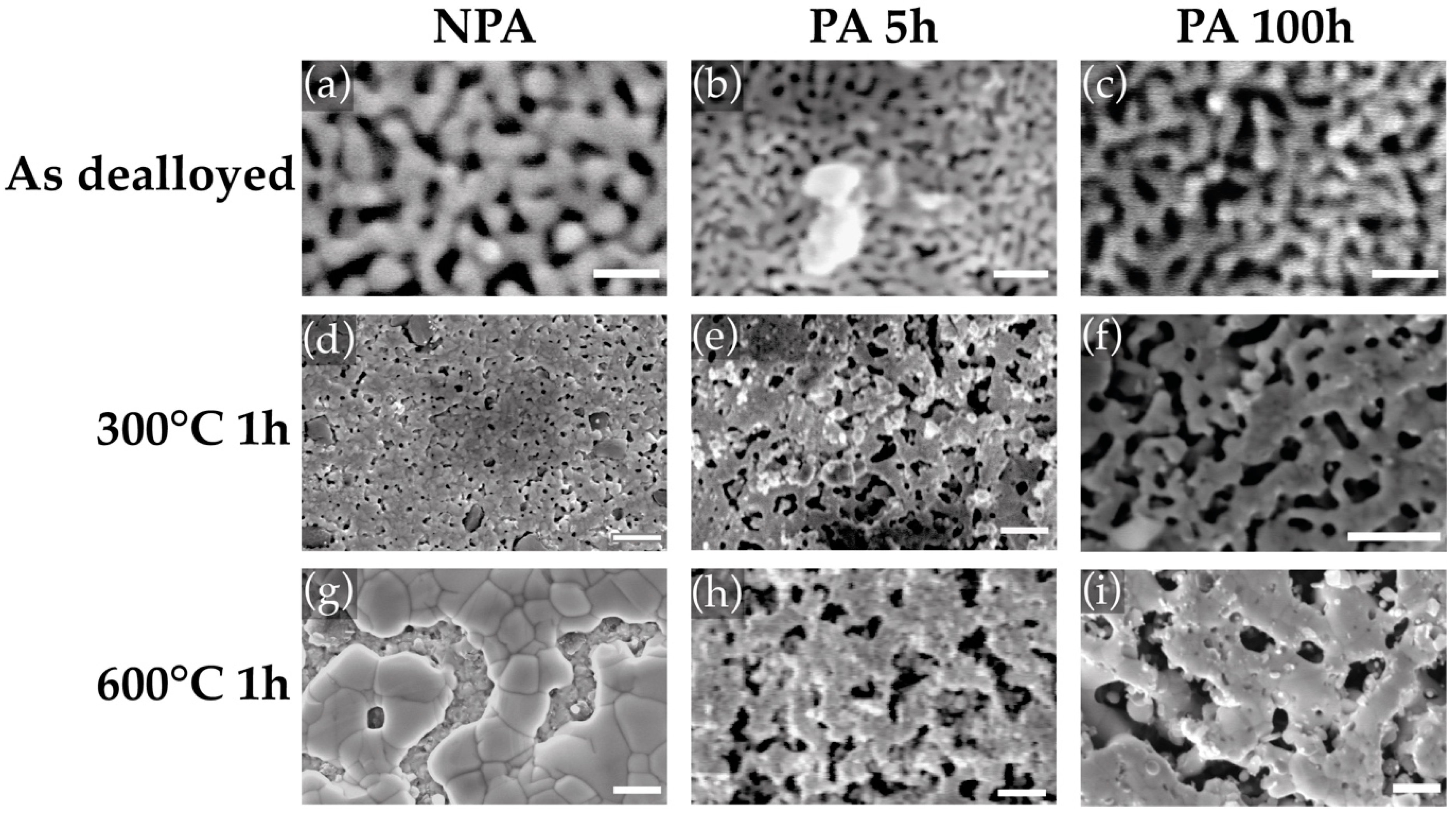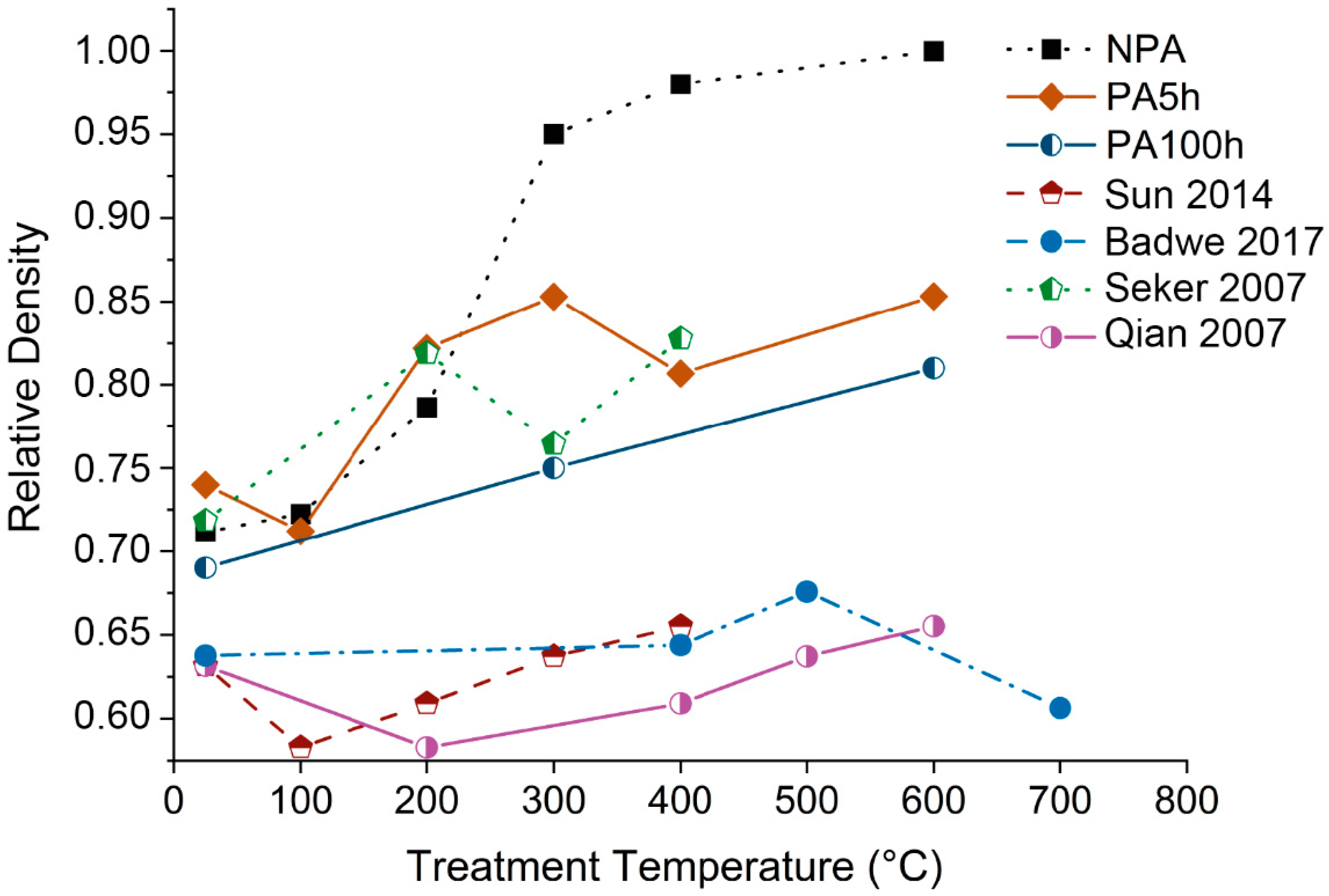Effects of the Parent Alloy Microstructure on the Thermal Stability of Nanoporous Au
Abstract
1. Introduction
2. Materials and Method
2.1. NP Au Fabrication
2.1.1. Au-Ag Alloy Fabrication
2.1.2. Dealloying of Au-Ag Alloy
2.1.3. Post-Dealloying Annealing Treatments
2.2. Scanning Electron Microscopy Measurements
2.3. X-ray Diffraction Measurements
2.4. Image Analysis
- Ligament diameters were measured manually through the Measure function;
- Pore diameters, pore densities, the perimeter per unit of surface, and the density of the material were measured through the function Analyze Particles. In this algorithm, pores are fitted as ellipses, and the mean diameter is estimated as the average between major and minor axis of the ellipse. In particular, the density of the material was estimated by the ratio between the number of the pixels with a value of “1” and the number of all pixels of the examined area.
3. Results and Discussion
3.1. Literature Image Analysis
3.2. Experimental Findings on Microstructure-Related Thermal Stability
4. Conclusions
Author Contributions
Funding
Institutional Review Board Statement
Informed Consent Statement
Data Availability Statement
Acknowledgments
Conflicts of Interest
References
- Lu, G.Q.; Zhao, X.S.S. Nanoporous Materials: Science and Engineering; Series on Chemical Engineering; Imperial College Press: London, UK, 2004; Volume 4, ISBN 1860943675. [Google Scholar]
- Vajtai, R. Springer Handbook of Nanomaterials; Springer Science & Business Media: Berlin/Heidelberg, Germany, 2013; ISBN 9783642205958. [Google Scholar]
- Ding, Y.; Zhang, Z. Introduction to Nanoporous Metals. In Nanoporous Metals for Advanced Energy Technologies; Springer International Publishing: Cham, Switzerland, 2016; pp. 1–35. [Google Scholar]
- Zhang, J.; Li, C.M. Nanoporous metals: Fabrication strategies and advanced electrochemical applications in catalysis, sensing and energy systems. Chem. Soc. Rev. 2012, 41, 7016–7031. [Google Scholar] [CrossRef] [PubMed]
- Ding, Y.; Zhang, Z. Nanoporous Metals for Advanced Energy Technologies; Springer International Publishing: Cham, Switzerland, 2016; ISBN 9783319297491. [Google Scholar]
- McCue, I.; Benn, E.; Gaskey, B.; Erlebacher, J. Dealloying and Dealloyed Materials. Annu. Rev. Mater. Res. 2016, 46, 263–286. [Google Scholar] [CrossRef]
- Hodge, B.A.M.; Hayes, J.R.; Caro, J.A.; Biener, J.; Hamza, A.V. Characterization and Mechanical Behavior of Nanoporous Gold. Adv. Eng. Mater. 2006, 8, 853–857. [Google Scholar] [CrossRef]
- Liu, M.; Zhao, J.; Luo, Z.; Sun, Z.; Pan, N.; Ding, H.; Wang, X. Unveiling Solvent-Related Effect on Phase Transformations in CsBr-PbBr2 System: Coordination and Ratio of Precursors. Chem. Mater. 2018, 30, 5846–5852. [Google Scholar] [CrossRef]
- Jin, H.J.; Weissmüller, J. Bulk nanoporous metal for actuation. Adv. Eng. Mater. 2010, 12, 714–723. [Google Scholar] [CrossRef]
- Kucheyev, S.O.; Hayes, J.R.; Biener, J.; Huser, T.; Talley, C.E.; Hamza, A.V. Surface-enhanced Raman scattering on nanoporous Au. Appl. Phys. Lett. 2006, 89, 053102. [Google Scholar] [CrossRef]
- Ma, C.; Trujillo, M.J.; Camden, J.P. Nanoporous Silver Film Fabricated by Oxygen Plasma: A Facile Approach for SERS Substrates. ACS Appl. Mater. Interfaces 2016, 8, 23978–23984. [Google Scholar] [CrossRef]
- Chen, L.Y.; Yu, J.S.; Fujita, T.; Chen, M.W. Nanoporous copper with tunable nanoporosity for SERS applications. Adv. Funct. Mater. 2009, 19, 1221–1226. [Google Scholar] [CrossRef]
- Zhang, L.; Song, Y.; Fujita, T.; Zhang, Y.; Chen, M.; Wang, T. Large Enhancement of Quantum Dot Fluorescence by Highly Scalable Nanoporous Gold. Adv. Mater. 2014, 26, 1289–1294. [Google Scholar] [CrossRef]
- Ruffino, F.; Grimaldi, M.G. Nanoporous Gold-Based Sensing. Coatings 2020, 10, 899. [Google Scholar] [CrossRef]
- Kolluri, K.; Demkowicz, M.J. Coarsening by network restructuring in model nanoporous gold. Acta Mater. 2011, 59, 7645–7653. [Google Scholar] [CrossRef]
- Qiu, H.; Xue, L.; Ji, G.; Zhou, G.; Huang, X.; Qu, Y.; Gao, P. Enzyme-modified nanoporous gold-based electrochemical biosensors. Biosens. Bioelectron. 2009, 24, 3014–3018. [Google Scholar] [CrossRef]
- Ding, Y.; Kim, Y.J.; Erlebacher, J. Nanoporous gold leaf: “Ancient technology “/advanced material. Adv. Mater. 2004, 16, 1897–1900. [Google Scholar] [CrossRef]
- Ng, A.K.; Welborn, S.S.; Detsi, E. Time-dependent power law function for the post-dealloying chemical coarsening of nanoporous gold derived using small-angle X-ray scattering. Scr. Mater. 2022, 206, 114215. [Google Scholar] [CrossRef]
- Jeon, H.; Kang, N.R.; Gwak, E.J.; Jang, J.; Han, H.N.; Hwang, J.Y.; Lee, S.; Kim, J.Y. Self-similarity in the structure of coarsened nanoporous gold. Scr. Mater. 2017, 137, 46–49. [Google Scholar] [CrossRef]
- Chen, A.Y.; Shi, S.S.; Liu, F.; Wang, Y.; Li, X.; Gu, J.F.; Xie, X.F. Effect of annealing atmosphere on the thermal coarsening of nanoporous gold films. Appl. Surf. Sci. 2015, 355, 133–138. [Google Scholar] [CrossRef]
- Kuwano-Nakatani, S.; Fujita, T.; Uchisawa, K.; Umetsu, D.; Kase, Y.; Kowata, Y.; Chiba, K.; Tokunaga, T.; Arai, S.; Yamamoto, Y.; et al. Environment-Sensitive Thermal Coarsening of Nanoporous Gold. Mater. Trans. 2015, 56, 468–472. [Google Scholar] [CrossRef]
- Seker, E.; Gaskins, J.T.; Bart-Smith, H.; Zhu, J.; Reed, M.L.; Zangari, G.; Kelly, R.; Begley, M.R. The effects of post-fabrication annealing on the mechanical properties of freestanding nanoporous gold structures. Acta Mater. 2007, 55, 4593–4602. [Google Scholar] [CrossRef]
- Sun, Y.; Burger, S.A.; Balk, T.J. Controlled ligament coarsening in nanoporous gold by annealing in vacuum versus nitrogen. Philos. Mag. 2014, 94, 1001–1011. [Google Scholar] [CrossRef]
- Gwak, E.J.; Kim, J.Y. Weakened Flexural Strength of Nanocrystalline Nanoporous Gold by Grain Refinement. Nano Lett. 2016, 16, 2497–2502. [Google Scholar] [CrossRef]
- Suryanarayana, C. Mechanical Alloying: A Novel Technique to Synthesize Advanced Materials. Research 2019, 2019, 4219812. [Google Scholar] [CrossRef] [PubMed]
- Rietveld, H.M. A profile refinement method for nuclear and magnetic structures. J. Appl. Crystallogr. 1969, 2, 65–71. [Google Scholar] [CrossRef]
- Lutterotti, L. Total pattern fitting for the combined size-strain-stress-texture determination in thin film diffraction. Nucl. Instrum. Methods Phys. Res. Sect. B Beam Interact. Mater. At. 2010, 268, 334–340. [Google Scholar] [CrossRef]
- Ding, Y.; Erlebacher, J. Nanoporous metals with controlled multimodal pore size distribution. J. Am. Chem. Soc. 2003, 125, 7772–7773. [Google Scholar] [CrossRef] [PubMed]
- Wittstock, A.; Wichmann, A.; Biener, J.; Bäumer, M. Nanoporous gold: A new gold catalyst with tunable properties. Faraday Discuss 2011, 152, 87–98. [Google Scholar] [CrossRef]
- Mangipudi, K.R.; Epler, E.; Volkert, C.A. Morphological similarity and structure-dependent scaling laws of nanoporous gold from different synthesis methods. Acta Mater. 2017, 140, 337–343. [Google Scholar] [CrossRef]
- Hakamada, M.; Mabuchi, M. Nanoporous gold prism microassembly through a self-organizing route. Nano Lett. 2006, 6, 882–885. [Google Scholar] [CrossRef]
- Viswanath, R.N.; Chirayath, V.A.; Rajaraman, R.; Amarendra, G.; Sundar, C.S. Ligament coarsening in nanoporous gold: Insights from positron annihilation study. Appl. Phys. Lett. 2013, 102, 253101. [Google Scholar] [CrossRef]
- Hakamada, M.; Mabuchi, M. Thermal coarsening of nanoporous gold: Melting or recrystallization. J. Mater. Res. 2009, 24, 301–304. [Google Scholar] [CrossRef]
- Hodge, A.M.; Biener, J.; Hayes, J.R.; Bythrow, P.M.; Volkert, C.A.; Hamza, A.V. Scaling equation for yield strength of nanoporous open-cell foams. Acta Mater. 2007, 55, 1343–1349. [Google Scholar] [CrossRef]
- Qian, L.H.; Yan, X.Q.; Fujita, T.; Inoue, A.; Chen, M.W. Surface enhanced Raman scattering of nanoporous gold: Smaller pore sizes stronger enhancements. Appl. Phys. Lett. 2007, 90, 3–6. [Google Scholar] [CrossRef]
- Kertis, F.; Snyder, J.; Govada, L.; Khurshid, S.; Chayen, N.; Erlebacher, J. Structure/processing relationships in the fabrication of nanoporous gold. JOM 2010, 62, 50–56. [Google Scholar] [CrossRef]
- Tan, Y.H.; Davis, J.A.; Fujikawa, K.; Ganesh, N.V.; Demchenko, A.V.; Stine, K.J. Surface area and pore size characteristics of nanoporous gold subjected to thermal, mechanical, or surface modification studied using gas adsorption isotherms, cyclic voltammetry, thermogravimetric analysis, and scanning electron microscopy. J. Mater. Chem. 2012, 22, 6733–6745. [Google Scholar] [CrossRef] [PubMed]
- Koifman Khristosov, M.; Dishon, S.; Noi, I.; Katsman, A.; Pokroy, B. Pore and ligament size control, thermal stability and mechanical properties of nanoporous single crystals of gold. Nanoscale 2017, 9, 14458–14466. [Google Scholar] [CrossRef] [PubMed]
- Badwe, N.; Chen, X.; Sieradzki, K. Mechanical properties of nanoporous gold in tension. Acta Mater. 2017, 129, 251–258. [Google Scholar] [CrossRef]
- Zeng, J.; Zhao, F.; Qi, J.; Li, Y.; Li, C.H.; Yao, Y.; Lee, T.R.; Shih, W.C. Internal and external morphology-dependent plasmonic resonance in monolithic nanoporous gold nanoparticles. RSC Adv. 2014, 4, 36682–36688. [Google Scholar] [CrossRef]
- Chauvin, A.; Molina-Luna, L.; Ding, J.; Choi, C.H.; Tessier, P.Y.; El Mel, A.A. Study of the Coarsening of Nanoporous Gold Nanowires by In Situ Scanning Transmission Electron Microscopy During Annealing. Phys. Status Solidi-Rapid Res. Lett. 2019, 13, 2–7. [Google Scholar] [CrossRef]
- Schindelin, J.; Arganda-Carreras, I.; Frise, E.; Kaynig, V.; Longair, M.; Pietzsch, T.; Preibisch, S.; Rueden, C.; Saalfeld, S.; Schmid, B.; et al. Fiji: An open-source platform for biological-image analysis. Nat. Methods 2012, 9, 676–682. [Google Scholar] [CrossRef]
- Rao, W.; Wang, D.; Kups, T.; Baradács, E.; Parditka, B.; Erdélyi, Z.; Schaaf, P. Nanoporous Gold Nanoparticles and Au/Al2O3 Hybrid Nanoparticles with Large Tunability of Plasmonic Properties. ACS Appl. Mater. Interfaces 2017, 9, 6273–6281. [Google Scholar] [CrossRef]
- Zhang, L.; Lang, X.; Hirata, A.; Chen, M. Wrinkled nanoporous gold films with ultrahigh surface-enhanced raman scattering enhancement. ACS Nano 2011, 5, 4407–4413. [Google Scholar] [CrossRef]
- Meyers, M.A.; Mishra, A.; Benson, D.J. Mechanical properties of nanocrystalline materials. Prog. Mater. Sci. 2006, 51, 427–556. [Google Scholar] [CrossRef]
- Svoboda, J.; Riedel, H. Quasi-equilibrium sintering for coupled grain-boundary and surface diffusion. Acta Metall. Mater. 1995, 43, 499–506. [Google Scholar] [CrossRef]
- Kingery, W.D.; Berg, M. Study of the initial stages of sintering solids by viscous flow, evaporation-condensation, and self-diffusion. J. Appl. Phys. 1955, 26, 1205–1212. [Google Scholar] [CrossRef]
- Hillman, S.H.; German, R.M. Constant heating rate analysis of simultaneous sintering mechanisms in alumina. J. Mater. Sci. 1992, 27, 2641–2648. [Google Scholar] [CrossRef]
- De Jonghe, L.C.; Rahaman, M.N. Sintering of Ceramics. In Handbook of Advanced Ceramics: Materials, Applications, Processing and Properties; Elsevier: Amsterdam, The Netherlands, 2003; Volume 1–2, pp. 187–264. ISBN 9780080532943. [Google Scholar]




Publisher’s Note: MDPI stays neutral with regard to jurisdictional claims in published maps and institutional affiliations. |
© 2022 by the authors. Licensee MDPI, Basel, Switzerland. This article is an open access article distributed under the terms and conditions of the Creative Commons Attribution (CC BY) license (https://creativecommons.org/licenses/by/4.0/).
Share and Cite
Pinna, A.; Pia, G.; Licheri, R.; Pilia, L. Effects of the Parent Alloy Microstructure on the Thermal Stability of Nanoporous Au. Materials 2022, 15, 6621. https://doi.org/10.3390/ma15196621
Pinna A, Pia G, Licheri R, Pilia L. Effects of the Parent Alloy Microstructure on the Thermal Stability of Nanoporous Au. Materials. 2022; 15(19):6621. https://doi.org/10.3390/ma15196621
Chicago/Turabian StylePinna, Andrea, Giorgio Pia, Roberta Licheri, and Luca Pilia. 2022. "Effects of the Parent Alloy Microstructure on the Thermal Stability of Nanoporous Au" Materials 15, no. 19: 6621. https://doi.org/10.3390/ma15196621
APA StylePinna, A., Pia, G., Licheri, R., & Pilia, L. (2022). Effects of the Parent Alloy Microstructure on the Thermal Stability of Nanoporous Au. Materials, 15(19), 6621. https://doi.org/10.3390/ma15196621







